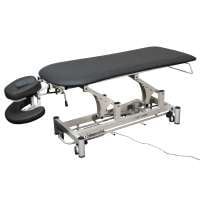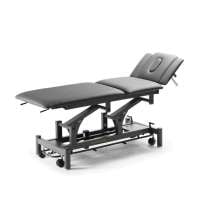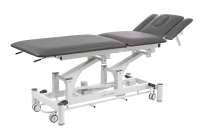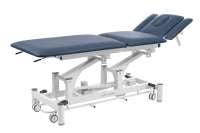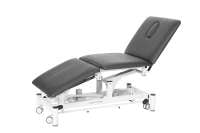
Physiotherapy is taking on an increasingly crucial role in healthcare as the importance of prevention and rehabilitation grows. However, despite the rising demand for physiotherapeutic services, we are facing a pressing problem - the shortage of skilled workers. In this blog post, we will delve into the main causes of the physiotherapy workforce shortage and present potential solutions to tackle this challenge.
-
The Causes
-
The Impact
-
Possible Solutions
-
Conclusion
1. The Causes of the Physiotherapy Workforce Shortage
The physiotherapy profession is undeniably an indispensable part of the healthcare system, playing a vital role in patient rehabilitation and care. So, how is it that we are facing a significant shortage of physiotherapists?
Demographic Shift and Increased Demand
The demographic shift is a significant driver of the heightened need for physiotherapists. People are living longer than ever before, leading to an increased prevalence of chronic illnesses that require intensive therapeutic care. Age-related issues such as joint problems, muscular dysfunctions, and neurological disorders are common reasons for the demand for physiotherapeutic interventions.
At the same time, society is witnessing a growing awareness of health. People are better informed about the importance of a healthy lifestyle and are increasingly seeking preventive measures to maintain their health and well-being. This combination of an aging population and increased health consciousness has led to a rapid surge in demand for physiotherapeutic services. However, this significant increase has resulted in an imbalance between supply and demand of physiotherapists. The capacities of training institutions and the access to training programs struggle to keep pace with the ever-growing demand. Consequently, we are experiencing a tangible shortage of skilled workers, which is progressively impacting the quality of healthcare and patient satisfaction.
Lack of Attractiveness of the Profession
Physiotherapy may be considered a fulfilling and meaningful profession for many, as it offers the opportunity to positively influence the lives of others and help them overcome health challenges. However, the profession also faces several challenges that diminish its attractiveness for potential professionals. These factors have led to fewer people choosing a career in physiotherapy, and some practicing therapists may even decide to leave the profession prematurely.
One main factor contributing to this issue is the high workload that physiotherapists endure. The work demands physical exertion and mental concentration. Treatment plans are often demanding and time-intensive, leading to high levels of stress and exhaustion. Especially in healthcare facilities with a high number of patients, constant work pressure can overwhelm many professionals, making it challenging to maintain a healthy work-life balance.
Another critical aspect that diminishes the profession's attractiveness is the inadequate remuneration. Despite the valuable role that physiotherapists play in healthcare, salaries often do not match the responsibility and complexity of their tasks. Particularly in certain healthcare systems, income opportunities do not align with the high requirements of expertise and skills needed for this profession. This financial uncertainty may lead many talented individuals to consider physiotherapy as a short-term career option rather than a long-term commitment.
Furthermore, limited opportunities for professional development are mentioned as another factor deterring potential professionals and possibly frustrating practicing therapists. In some healthcare systems, there are restricted possibilities for specialized therapists to advance to higher positions or further develop their skills. The lack of career prospects can impede motivation and push qualified physiotherapists to seek alternative career options where they can better utilize their abilities.
Education and Training
A shortage of training facilities results in insufficient study places for aspiring physiotherapists to meet the increasing demand for skilled professionals. This scarcity can create bottlenecks and make access to physiotherapy education more challenging. In some regions or countries, long waiting periods for a training spot may discourage potential candidates from pursuing a career in physiotherapy.
Additionally, high admission requirements for studying physiotherapy can also pose a barrier. The profession demands a high level of commitment, responsibility, and empathy to work effectively and safely with patients. Proper selection of suitable candidates is essential to maintain the quality of physiotherapeutic care at a high level. However, strict admission criteria could result in potentially talented and motivated applicants being rejected, thereby widening the gap between the supply and demand for skilled professionals.
To address the physiotherapy workforce shortage, measures are necessary to expand training capacities and improve access to physiotherapy education.

2. The Impact of the Skilled Labor Shortage on Healthcare
The shortage of physiotherapists has significant effects on healthcare:
-
Long waiting times and restricted access to care: The lack of skilled professionals leads to extended waiting periods for patients in urgent need of physiotherapy treatments. This can delay recovery and negatively affect the quality of life for those affected.
-
Increased workload for physiotherapists: The rising patient demand and limited resources put immense pressure on the remaining physiotherapists. Overburden can result in fatigue, burnout, and a decline in the quality of their work.
-
Potential impact on professional quality and patient safety: The high workload and shortage of skilled professionals may adversely affect the quality of treatment and patient safety. Errors can occur when the remaining therapists are overwhelmed and do not have sufficient time to attend to each patient adequately.
According to a study by the DKI (German Hospital Institute) referring to the situation in Germany, approximately 15 percent of nursing positions in hospitals were vacant in 2018. The skilled labor shortage led to increased workloads for the remaining staff and longer waiting times for patients.
3. Possible Solutions
The skilled labor shortage in physiotherapy poses a serious challenge to healthcare. To counter this situation, targeted approaches are necessary, which can be implemented both at the political level and through active engagement of physiotherapists themselves.
Political Measures
The government and healthcare authorities should take the skilled labor shortage seriously and implement targeted measures. This includes:
-
Creating incentives for aspiring physiotherapists
-
Improving working conditions
-
and promoting an increase in training capacities
Enhancing the Profession's Attractiveness
Professional associations and employers can contribute to making the profession of physiotherapy more attractive by:
-
Improving career opportunities
-
Offering adequate remuneration
-
and promoting work-life balance
In addition, image campaigns are essential to raise awareness about the importance of physiotherapy.
International Collaborations
One way to alleviate the skilled labor shortage is by recruiting professionals from abroad and promoting international collaborations. This can temporarily fill gaps in healthcare and foster the exchange of knowledge and best practices.
The Role of Physiotherapists and Professional Associations
Physiotherapists themselves can contribute to addressing the skilled labor shortage:
1. Taking initiative and networking
It is essential for physiotherapists to actively advocate for their interests, highlight shortcomings, and propose solutions. Networks and professional associations provide a platform to collectively represent the concerns of skilled professionals.
2. Professional Associations
Through active participation in professional associations, physiotherapists can strengthen their voice and influence political decisions. Together, they can develop solutions and advocate for an improved professional situation.
Conclusion
Physiotherapy plays an increasingly crucial role in healthcare as the significance of prevention and rehabilitation grows.
An aging population, increased health awareness, and the demand for qualified physiotherapists are some of the main causes that have led to a noticeable skilled labor shortage. High workload, inadequate remuneration, and limited career opportunities have diminished the profession's attractiveness, resulting in fewer people choosing the career and possibly leading some practicing therapists to leave prematurely.
To address the skilled labor shortage, targeted measures are required.
-
At the political level, incentives should be created for aspiring physiotherapists, working conditions improved, and training capacities expanded.
-
Professional associations and employers can contribute by improving career opportunities, offering adequate remuneration, and promoting work-life balance.
-
Image campaigns are also crucial to raise awareness about the importance of physiotherapy.
-
International collaborations and the recruitment of professionals from abroad can help temporarily fill gaps in healthcare and promote the exchange of knowledge. The role of physiotherapists themselves is critical. Taking initiative, engaging in professional associations, and networking can help represent the concerns of skilled professionals and collectively develop solutions.
By implementing these measures and actively addressing the skilled labor shortage, we can ensure that physiotherapy continues to provide high-quality healthcare and positively impact the well-being and recovery of patients. It is crucial for all relevant stakeholders to work together to address this important challenge and secure a strong and sustainable future for physiotherapy.
Wie hat Ihnen der Blogbeitrag gefallen?
Ihr Feedback hilft uns dabei, unsere Beiträge zu verbessern.
❤️ Sehr interessant! - ☺️ Okay. - ☹️ Nicht interessant.







